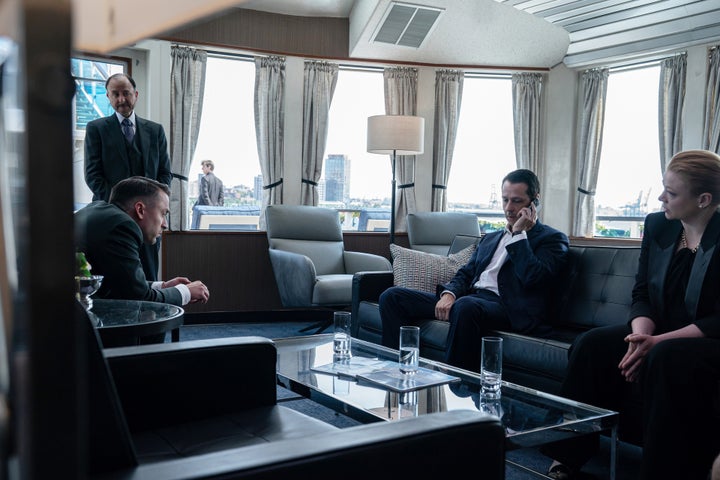
Sunday night’s stunning episode of HBO’s “Succession” featured a breathtaking sequence of events: The four Roy siblings — Kendall (Jeremy Strong), Shiv (Sarah Snook), Roman (Kieran Culkin) and Connor (Alan Ruck) — reacting to and processing the news that their father, media mogul Logan Roy (Brian Cox), had suddenly died. It made for astonishing television on many levels, partly because much of the episode unfolded in real time, plunging viewers directly into the chaos and confusion the characters were experiencing.
A significant portion of the episode was shot primarily in one 27-minute-long continuous take, according to the episode’s director Mark Mylod. The crew hid rolls of film around the boat the siblings were on to quickly reload the cameras and ensure at least one was always running. It’s an impressive feat that added to the episode’s visceral sense of urgency, anxiety and shock.
The episode magnifies how the show’s relatively simple relationship to time has made for some pretty incredible television. While other shows might juggle multiple timelines to illustrate how a character’s past informs their present or future or to introduce new mysteries for viewers to debate, everything on “Succession” occurs in the present. When the show’s events move forward in time, it’s often a very short increment, like a few days or even a few hours, never a massive jump. Sticking to just one timeline and making minimal shifts in time have facilitated many of the show’s biggest turning points.
We follow the Roys in real-time or fairly close to it on several occasions. In Season 1, Kendall kills a server in a car accident. We see him stumble into the car with the server, lose control and crash into a lake. After emerging from the lake, he rejoins his family at Shiv and Tom’s wedding, dusting himself off as if nothing happened. All of this happens with minimal breaks in the action. At the end of Season 2, there’s a similar effect during the chain of events leading up to and including Kendall’s press conference, in which he suddenly announces he’s turning on Logan. Then, the opening episode of the third season picks up almost immediately after that moment, following the characters as they deal with the fallout of that seismic shift.
In the Season 3 finale, most of the episode’s second half unfolds largely in real time, starting with Shiv finding out Logan is finalizing a deal to sell Waystar Royco and cut out the kids. She goes to tell Kendall, who then has a breakdown and confesses to Shiv and Roman that he killed the server. Immediately after, the three siblings get into a car to confront Logan at his villa, and while in the car, they decide to unite against him and thwart the deal. When they reach Logan, they find out he has already out-maneuvered them, thanks to — as they (and we) learn at the very end — Shiv’s husband Tom (Matthew Macfadyen) backstabbing her. Because the show never breaks from the present and often progresses over a very short time, we feel a sense of immediacy. We’re closely observing every character’s every move and then reeling from the show’s most stunning twists and turns as they happen.

On TV, especially when we talk about “prestige TV,” ambition is often associated with a show using nonlinear storytelling and creating intrigue out of complicating the viewer’s sense of time. It can obviously be done to great effect, and over the years, many shows have been groundbreaking precisely because they’ve found bold ways to experiment with time.
“Lost” continually kept audiences engaged with its flashbacks, flashforwards, and the more debatable “flash-sideways” plotlines toward the end of its six-season run. More recently, “This Is Us” utilized as many as three timelines in a given episode to poignantly explore how the Pearson family’s past tragedies informed their present and, eventually, their future. “The Affair,” tells the story and aftermath of an extramarital affair from multiple characters’ perspectives. “Russian Doll” placed its characters in a time loop, repeating the same day over and over again. Sometimes, a single variation in time can pack a massive punch, like the flashforward montage in the final minutes of the series finale of “Six Feet Under.”
How TV shows play around with time is often fascinating to observe. Shows can jump back and forth between timelines or introduce alternative timelines, such as a “sliding doors” moment. On a basic level, it’s common for a show to have at least two timelines, such as incorporating flashback scenes that inform a character’s actions in the present. Some shows introduce entire flashback episodes or a set of flashback episodes before returning to the show’s present-day timeline.
But once it has happened enough times, it can be too obvious and rote. Instead of, for instance, building out a character’s backstory with a flashback to a younger version of the character, why not just allude to it in a few lines of dialogue or through a choice an actor makes in a given scene?
Even when multiple timelines are integral to the show, it can become unwieldy. The new season of Showtime’s “Yellowjackets” remains full of intrigue as we follow the high school soccer team members who somehow survived 19 months of being stranded in the woods (spoiler alert: it was cannibalism); and their adult selves 25 years later. But with its sprawling cast of characters across two timelines, the show is now running the risk of making viewers go down a few too many rabbit holes and generating more questions than answers.
Sometimes, keeping the show’s timeline relatively simple and showing us only the present day can actually make for more effective storytelling. For example, on “Succession,” it’s telling that other than in the sepia-toned home video footage in the show’s iconic opening credits sequence, we never see the Roys’ pasts. A different, arguably lesser, show might feature flashbacks about the siblings’ traumatic childhoods or employ a few departure episodes where we learn about their backstories before returning to the present.
On “Succession,” we don’t need shifts in time to tell us why the Roys have become the terrible idiots they are. It’s a show where what we don’t see is often just as fascinating as what we do see, like the way someone responds to a piece of information, not the information itself. With the laser-like focus on the present, we instantly understand and recognize the specificity of every Roy sibling’s response to Logan dying. We don’t need a flashback to know why Roman is in denial about it, constantly deflecting trauma and avoiding conflict. Similarly, we understand why Shiv reverts to a more child-like version of herself, why Kendall tries to take control of the situation, or why Connor is, of course, forgotten. Thanks to the precision of the acting, the writing and the way each shot is framed, we just know because we’ve seen it play out in the present and closely observed all of it over the show’s four seasons.
It can be refreshing to watch a show where we just focus on the present and nothing else. Another one of the best shows on TV right now is ABC’s “Abbott Elementary.” While very different from “Succession” in nearly all other ways, everything on “Abbott” so far has happened on one present-day timeline. We’ve closely observed Janine (Quinta Brunson) and her colleagues, learning about them through their reactions and bits of dialogue that hint at past events. In this week’s episode, the show introduced Janine’s mom Vanetta (Taraji P. Henson), after previously alluding to her in earlier episodes. We don’t need to see a flashback to understand Janine’s fraught relationship with Vanetta, why Janine has trouble setting boundaries, and why she gravitates toward someone like Barbara (Sheryl Lee Ralph) and considers her “my work mom.”
Not coincidentally, both shows have specific techniques and structures that ground the action in the present. On “Abbott,” the mockumentary format means we only see what’s directly in front of us and what the “documentary crew” captures. “Succession” employs documentary-style camera work: The cameras often hover around characters, sweep across a room, or weave in and out of conversations — as if we, the audience, are peering into these terrible people’s lives.
During Kendall’s cringe-y “L to the OG” rap in Season 2, he describes his father as: “A1 ratings, 80K wine / Never gonna stop, baby / fuck Father Time, bro.” Now, Logan is gone, a reminder of the cold, hard truth that nobody can outrun Father Time. And the way “Succession” treats the concept of time with simplicity makes the show all bangers, all the time.
